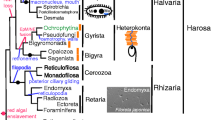Summary
The pigmented spots of bryozoan larvae have often been implicated in photoreception due to their preferential occurrence in larvae with positive phototactic behavior. Results of light and electron microscopic studies of Bugula neritina show that the larvae possess two spots, each with a basal sensory cell situated at the base of a pit-like depression. The embedment of the pit and its basal cell in a pad of subepidermal pigment cells allows for directional illumination. The basal sensory cell produces a ball-like mass of non-motile cilia. The configuration of the axoneme is typical of kinocilia and unlike the arrangement previously described for ciliary photoreceptors. Elaboration of receptor organelle membrane surface area is accomplished uniquely by multiple cilia oriented so that large portions of each cilium lie perpendicular to the direction of incident light. The pigmented spot directly contacts the underlying equatorial nerve ring which also connects with the major larval locomotor organ. The pigmented spots of B. neritina are the only potential photoreceptor structures which have been studied by electron microscopy in the three lophophorate phyla. The use of ciliary membranes as the potential photoreceptor organelle allies the bryozoan pigmented spot with the ciliary type photoreceptor which occurs most prevalently in deuterostome animals.
Similar content being viewed by others
References
Barrois, J.: Recherches sur l'Embryologie des Bryozoaires. Thesis, Lille 305 p. (1877).
Calvet, L.: Contributions à l'Histoire Naturelle des Bryozoaires Ectoproctes Marins. Thesis, Montpellier et Paris, 488 p. (1900).
Eakin, R. M.: Lines of evolution of photoreceptors. In: D. Mazia and A. Tyler, eds., General physiology of cell specialization, p. 393–425. New York: McGraw-Hill Book Co. 1963.
—: Evolution of photoreceptors. In: T. Dobzhansky, M. Hecht, and W. Steese, eds., Evolutionary biology, Vol. 2, p. 194–242. New York: Appleton-Century-Crofts 1968.
- Structure of invertebrate photoreceptors. In: H. Dartnall, ed., Handbook of sensory physiology, vol. VII/1. Berlin-Heidelberg-New York: Springer (In press).
Furshpan, E. J., Potter, D. D.: Low-resistance junctions between cells in embryos and tissue culture. In: A. Moscona and A. Monroy, eds., Current topics in developmental biology, vol. 3, p. 95–127. New York: Academic Press, Inc. 1968.
Hyman, L. H.: The invertebrates. V. Smaller coelomate groups, viii + 783 p. New York: McGraw-Hill, 1959.
Long, J. A.: The embryology of three species representing three superfamilies of articulate Brachiopoda. Dissertation. University of Washington, 239p. 1964.
Loewenstein, W. R., Kano, Y.: Studies on an epithelial (gland) cell junction. I. Modifications of surface membrane permeability. J. Cell Biol. 22, 565–586 (1964).
Luft, J. H.: Improvements in epoxy resin embedding methods. J. biophys. biochem. Cytol. 9, 409–444 (1961).
Lynch, W. F.: The behavior and metamorphosis of the larvae of Bugula neritina (Linnaeus): experimental modification of the length of the free-swimming period and the responses of the larvae to light and gravity. Biol. Bull. 97, 115–150 (1947).
Mawatari, S.: The natural history of a common fouling bryozoan Bugula neritina (Linnaeus). Misc. Rep. Res. Inst. Nat. Res. No 19–21, 47–54 (1951).
Plenk, H.: Die Entwicklung von Cisttela (Argiope) neapolitana. Arb. zool. Inst. Wien 20, 93–108 (1913).
Reynolds, E. S.: The use of lead citrate at high pH as an electron-opaque stain in electron microscopy. J. Cell Biol. 17, 208–212 (1963).
Richardson, K. C., Jarret, L., Finke, E. H.: Embedding in epoxy resins for ultrathin sectioning in electron microscopy. Stain Technol. 35, 313–323 (1961).
Ryland, J. S.: Experiments on the influence of light on the behaviour of polyzoan larvae. J. exp. Biol. 37, 783–800 (1960a).
—: The British species of Bugula (Polyzoa). Proc. Zool. Soc. Lond. 134, 5–105 (1960b).
Thorson, G.: Light as an ecological factor in the dispersal and settlement of larvae of marine bottom invertebrates. Ophelia 1, 167–208 (1964).
Watson, M. L.: Staining of tissue sections for electron microscopy with heavy metals. J. biophys. biochem. Cytol. 4, 475–478 (1958).
Woollacott, R. M., Zimmer, R. L.: Attachment and metamorphosis of the cheilo-ctenostome bryozoan Bugula neritina (Linné). J. Morph. 134, 351–382 (1971).
Author information
Authors and Affiliations
Additional information
This investigation was supported by research grant GB-18802 from the National Science Foundation and Biomedical Support grants FR-0712-02, 03, 04 from the National Institutes of Health. Contribution no. 2 from the Santa Catalina Marine Biological Laboratory.
The authors are indebted to Dr. Richard M. Eakin, of the University of California at Berkeley, for his thoughtful criticism of the manuscript.
Rights and permissions
About this article
Cite this article
Woollacott, R.M., Zimmer, R.L. Fine structure of a potential photoreceptor organ in the larva of Bugula neritina (Bryozoa). Z. Zellforschung 123, 458–469 (1972). https://doi.org/10.1007/BF00335542
Received:
Issue Date:
DOI: https://doi.org/10.1007/BF00335542




